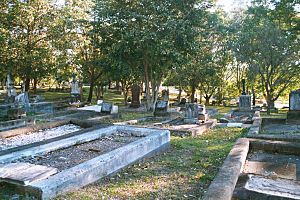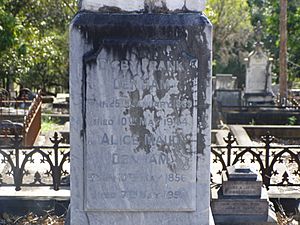South Brisbane Cemetery facts for kids
Quick facts for kids South Brisbane Cemetery |
|
|---|---|

South Brisbane Cemetery
|
|
| Location | 21 Fairfield Road, Dutton Park, City of Brisbane, Queensland, Australia |
| Design period | 1840s–1860s (mid-19th century) |
| Built | 1870 – 1990s |
| Official name: South Brisbane Cemetery, Dutton Park Cemetery | |
| Type | state heritage (landscape, built) |
| Designated | 1 October 2003 |
| Reference no. | 602406 |
| Significant period | 1870-1990s (fabric) 1870-1990s (historical use) |
| Significant components | fence/wall – perimeter, gate – entrance, amenities building, headstone, trees/plantings, burial/grave, grave marker, toilet block/earth closet/water closet, memorial/monument, pathway/walkway, office/administration building, road/roadway, grave surrounds/railings |
| Lua error in Module:Location_map at line 420: attempt to index field 'wikibase' (a nil value). | |
The South Brisbane Cemetery is a special historical place located in Dutton Park, Brisbane, Australia. It sits right next to the Brisbane River. This cemetery was built over many years, starting in 1870 and continuing into the 1990s. It is also known as Dutton Park Cemetery. This important site was added to the Queensland Heritage Register on October 1, 2003, because of its history and unique features.
The cemetery was first set up in 1866. It was actively used for burials until the 1960s. After that, it became harder to find space for new graves.
Contents
History of the Cemetery
How the Cemetery Started
Back in 1851, people in South Brisbane found out that the government had set aside about 5 acres of land for a cemetery. This was before Queensland became its own state. However, no one was ever put in charge, and no burials happened there. In 1865, the Queensland Government decided to sell that land. They used the money to help create a new burial ground.
In 1866, the Queensland Government gave 18 acres of land for the South Brisbane Cemetery. Five people were chosen to manage it. The first person buried here was Jane Hockings in July 1870.
Why Cemeteries Changed
For a long time, people were buried in churchyards in Europe. But as cities grew, these churchyards became too small. Following ideas from France, towns in Britain and Australia started setting aside land outside the main towns for public cemeteries. This was thought to be healthier. It also created a large, beautiful space where gravestones and plants could be arranged nicely. Brisbane's first public cemetery of this kind was in Milton in the 1840s.
Developing the Area
The area now called Dutton Park was once covered in thick trees and had steep valleys. A rough path from Woolloongabba to Ipswich went through it. Some farms started in the 1840s. A road was planned, and a bridge over the river was built in the 1860s. But there were still very few houses.
In 1863, the Dutton Park area was surveyed. A large park area was set aside. Later, it was divided into areas for recreation and cemeteries. The Cemetery Act of 1865 allowed the government to create public cemeteries. These would be managed by local groups. The South Brisbane Cemetery officially opened on May 7, 1870.
Getting Around to the Cemetery
The South Brisbane Cemetery was one of several government areas in the region. A public park is next to its northern side. There were also areas for a police pound, a jail, an asylum, and an orphanage nearby. As public transport became available, more people moved to the area. A train station opened in 1884. The first horse-drawn bus service to the city started in 1890. The main road and railway line are close to the cemetery. This was important for funeral groups and visitors before most people had cars.
In 1881, a Caretaker's Cottage was built. In 1888, beautiful entrance gates, railings, and a boundary wall were designed by a famous architect named AB Wilson.
Growing the Cemetery
In 1904, permission was given to add 7 acres of land to the cemetery. This land was on the south side of Cornwall Street. Adding it to the cemetery meant that a part of Cornwall Street was closed off. In 1891, the boundary wall was extended.
In 1908, a tram line reached the area. Its end stop was near the cemetery. The area grew quickly in the 1900s. In 1914, it was renamed Dutton Park. This was to honor C B Dutton, who was in charge of public lands. By the late 1920s, the suburb was considered a nice place to live. In 1925, the Greater Brisbane Council was formed. The Brisbane City Council took over managing public cemeteries in the city area in August 1930. This included the South Brisbane Cemetery.
In 1930, the section of Cornwall Street that is now inside the cemetery was officially closed as a public road.
Improvements and Changes
In 1939, the Brisbane City Council started a big project to improve the cemetery. Over the next few years, they laid concrete paths. They also improved the internal roads and added kerbs. A stone wall was built inside the cemetery. A new fence was put up from the existing iron railings in Cornwall Street to the cemetery corner. Two modern brick toilet blocks were built in 1941. The landscaping was also improved with many new trees and shrubs. These included cypress pines and blue gums along the Brisbane River.
Work on the cemetery stopped during World War II because of shortages. But it started again in 1945. A survey noted the toilet blocks, two shelter sheds, a caretaker's cottage, a tool room, a motor shed, and a staff room. A brick staff building was built in 1954.
Stories in Stone
The gravestones in the cemetery tell many stories. Some belong to important early residents. These show amazing carving skills. Others belong to prisoners from the nearby Brisbane Gaol. The memorials also show how diverse the South Brisbane area became after World War II. You can find Greek and Italian graves. There are also graves of many Russian people who settled in the area in the 1920s. The cemetery also has the graves of 50 soldiers who died in World War II.
Visiting graves regularly has become less common today. Also, more people choose cremation instead of burial. Cemeteries built since 1950 often have flat plaques on the ground. This is different from older cemeteries like South Brisbane, which have many kinds of memorials. The cemetery stopped taking new burials in 1961–1962. However, families can still use their existing plots. A few new plots were also made available in 1998–1999. In 1996, the Caretaker's cottage burned down. The shelter sheds are also gone.
War Graves
There are 52 service members from the Commonwealth buried here. Their graves are looked after by the Commonwealth War Graves Commission. Thirteen of them are from World War I, and 39 are from World War II.
Current Use
By the early 1960s, the cemetery was mostly full and was closed for new burials. However, like many closed cemeteries, additional burials and the placing of ashes in existing family graves still happen. Some new plots were also made available in the 1990s.
What the Cemetery Looks Like
The South Brisbane Cemetery covers a large area of hilly land. It slopes from the ridge at Annerley Road down to T J Doyle Memorial Drive, which is near the Brisbane River. There are valleys in the middle part. The way graves and plants are arranged largely follows the shape of the land.
The cemetery is a special memorial area. It is surrounded by walls and fences. The main entrance is on Annerley Road. It has fancy gates with Iron railings shaped like spears. These are set into a low sandstone wall. The entrance has two wrought iron gates between decorative sandstone pillars for cars. There is also a gate for people walking. The gates match the railings and have iron spears with a wavy, vine-like design.
From the main entrance, two curving roads go left and right. There is a formal planting area near the main entrance. But generally, the plants are arranged more naturally, fitting the land. There are many different kinds of plants, both native and from other places. The burials are arranged more formally in close rows, facing east-west, where the land allows. Concrete paths run between them. Many different types of memorials mark the graves. Some of the oldest memorials are large and detailed. They show symbols from the Victorian era related to death, like broken columns, angels, and vine leaves. Jane Hocking's grave, the oldest in the cemetery, has a carved angel holding onto a cross on top of a tall, thin column.
Buildings from the 1940s improvement project are still there. These include small brick toilet blocks. There is also a brick building that was used as an office, store, and garage. A staff building was built in 1954.
The cemetery also has a Trig marker. This was part of a survey of the South East region done by the government in 1883. It is a sandstone block with markings on top. It is now covered by a concrete path.
Why the Cemetery is Important
The South Brisbane Cemetery is listed on the Queensland Heritage Register because it is very important.
- It shows Queensland's history: It is one of the oldest cemeteries in Queensland, used since 1870. Its design, memorials, and plants show how Brisbane grew and how people in Queensland buried their dead.
- It helps us learn about history: The cemetery can teach us about changes in burial customs from the 1800s and 1900s. The gravestones and what is written on them also tell us about the people who lived in the area.
- It is a great example of a public cemetery: It's a good example of a public cemetery that has been used since 1870. It has memorials for important early residents and even for people who were prisoners. Its park-like setting and high location (to be healthier) are typical of cemeteries from the late 1800s. It also includes all religious groups.
- It is beautiful: The cemetery is a beautiful public space. It has lovely landscapes, old trees, plants, buildings, and memorials. Many of the monuments are very artistic and well-made.
- It is special to the community: The cemetery is very important to the people of Brisbane for social and spiritual reasons. It helps people honor and remember those who have passed away, which is still a very important tradition.
The Friends of South Brisbane Cemetery
The Friends of South Brisbane Cemetery (FOSBC) is a group of volunteers. They work to research and protect the South Brisbane Cemetery. The group started in 2005. Three local women were worried about how neglected the cemetery looked. Over the years, they did a huge amount of work. They cleaned and recorded every grave. This helped them create their own database of records. They also successfully asked the Brisbane City Council to return many old gravestones that were found during the building of the nearby Eleanor Schonell Bridge.
The FOSBC officially became a non-profit group in May 2017.
The members research the graves and the people buried there. They have helped hundreds of people find their relatives in the cemetery. The FOSBC also organizes popular "Guardian Angels" cleaning days. Hundreds of people have joined these events. They also run many tours that are not for profit. The money from these tours helps fund cemetery history and maintenance projects.
People Buried Here
- Ernest Austin, the last person to be executed in Queensland.
- Eleanor Bourne, the first woman from Queensland to study medicine.
- Henry Challinor (1814–1882), a doctor and politician in early Queensland.
- Digby Denham, a politician and former Premier of Queensland.
- Archibald Meston, an Australian politician and explorer.
- Harold Parker, a famous sculptor.
- Harry Turley, a politician and former President of the Australian Senate.
- Janet Walker, a costume designer and inventor.


